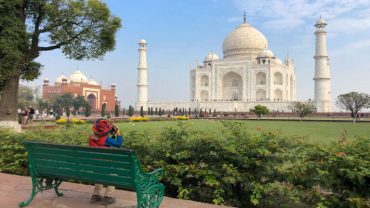Fatehpur Sikri: The Enigmatic Ghost City of Mughal Splendor
Hidden in the arid landscape just a short drive from Agra, the city of Fatehpur Sikri emerges like a mirage from the past. This abandoned Mughal city, often referred to as a “ghost city,” is a testament to the grandeur and mysteries of the Mughal era. Fatehpur Sikri, a UNESCO World Heritage Site, holds within its sandstone walls a rich history, stunning architecture, and an enigmatic aura that continues to captivate travelers from around the world.
A Royal Vision
Fatehpur Sikri, which means “City of Victory,” was built by the Mughal Emperor Akbar in 1569. The city’s creation was inspired by Akbar’s dream of a son, and when his wish was fulfilled with the birth of a son and heir, he decided to build a magnificent city to commemorate his good fortune. This city was envisioned as a grand imperial capital and a symbol of Akbar’s authority.
Architectural Marvels
The architectural brilliance of Fatehpur Sikri is undeniable. The city is primarily constructed from red sandstone, which imparts a warm, earthy hue to the structures. Its unique blend of Persian, Indian, and Islamic architectural styles results in a stunning fusion of artistic influences.
One of the most remarkable structures in Fatehpur Sikri is the Buland Darwaza, or “Gate of Magnificence.” This colossal entrance is both imposing and intricately designed, boasting intricate calligraphy and geometric patterns. It’s said to be the highest gateway in the world and a symbol of Akbar’s victorious reign.
The Jama Masjid, a grand mosque within the city, is known for its impressive courtyard and ornate pillars. It’s a place of worship that reflects the harmony and synthesis of different architectural traditions during Akbar’s rule.
Sufi Influence
Fatehpur Sikri is also home to the shrine of the revered Sufi saint, Sheikh Salim Chishti. The saint’s tomb, known as the Salim Chishti Dargah, is an important pilgrimage site for devotees from various faiths. The white marble tomb, with its delicate lattice work, is a symbol of the enduring spirituality that reverberates within the city’s walls.
Abandonment and Mysteries
Despite its architectural splendor, Fatehpur Sikri was abandoned after just 15 years as the capital of the Mughal Empire. Water scarcity and a lack of resources forced Akbar to relocate the capital to Lahore. The city remained largely deserted for centuries, with its buildings slowly succumbing to the elements.
The reason for its abandonment remains a subject of debate and speculation among historians. Some believe that water scarcity and an unstable political climate led to its desertion, while others suggest that it was a deliberate move to shift the capital closer to the North-West frontier.
Today, the ghost city of Fatehpur Sikri stands as a captivating enigma. Its well-preserved structures and monuments seem frozen in time, offering visitors a unique opportunity to step back into the golden age of the Mughal Empire. The whispering winds through its empty courtyards and the stories etched into its walls create an atmosphere of intrigue and mystique.
A Time Capsule of Mughal Life
Fatehpur Sikri provides an invaluable insight into the daily life, art, and culture of the Mughal period. The buildings, with their intricate carvings and frescoes, showcase the craftsmanship and artistic sensibilities of the era. The city’s layout, with its well-planned streets and bazaars, reflects the administrative acumen of Akbar.
The Panch Mahal, a five-story palace, served as a cool retreat for the emperor and his queens during hot summers. Its open design allowed for ventilation and panoramic views of the city.
Exploring Fatehpur Sikri Today
Today, Fatehpur Sikri is a well-preserved historical site that attracts visitors from around the world. A visit to this enigmatic city is like stepping into a time machine, allowing you to wander through the courtyards, palaces, and mosques that once bustled with life.
The intricate details of the architecture, the ornate carvings, and the spiritual ambiance of the Salim Chishti Dargah continue to enthrall visitors. The Buland Darwaza, standing tall and proud, beckons travelers to pass through its gates and immerse themselves in the rich history of the Mughal Empire.
A Journey into the Past
Fatehpur Sikri is not merely a collection of stone structures; it’s a portal to a bygone era. The ghost city, with its mysteries and architectural marvels, is a reminder of the transient nature of empires and the enduring legacy of art and culture.
As you explore the lanes of Fatehpur Sikri, you can almost hear the echoes of the past, feel the whispers of history, and imagine the royal court in all its splendor. Fatehpur Sikri is a treasure trove of stories waiting to be uncovered, an enigmatic city that continues to cast its spell on all who venture within its sandstone walls.
Thank & Regards
Sarfaraz elahie
The GetExplore Writter
Contact Us
Have questions or need assistance? Feel free to reach out to our dedicated team. We’re here to help you plan your next adventure.




Comment (0)